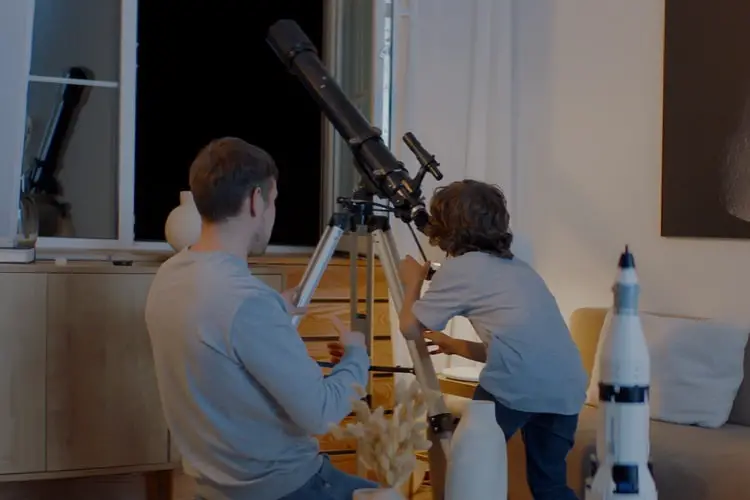So, you’ve decided to set aside more time to spend with your children. What’s an activity that would harness their curiosity, imagination, and a sense of shared exploration and discovery? Look no further than as far as you can look. Astronomy for kids is a fun and educational pastime you’ll both enjoy.
Children learn more effectively if they are interested in the topic being taught. Some of the most popular topics among kids are planets, astronauts, and space. Astronomy can therefore be a highly effective way to introduce your children to STEM subjects.
In this article you will learn how to get your children started with astronomy and stargazing, what activities you can do together, and which tools to use in the process.
- Astronomy for Kids: What is Astronomy?
- How to Find the Best Place to Stargaze with Kids
- How to Get Your Kids Started in Astronomy
- What to Look For (and When)
- What Makes Astronomy So Cool?
- What Do Kids Need for Stargazing?
- How to Get Kids Excited About Astronomy
- A Few Important Stargazing Dos and Don’ts
Astronomy for Kids: What is Astronomy?
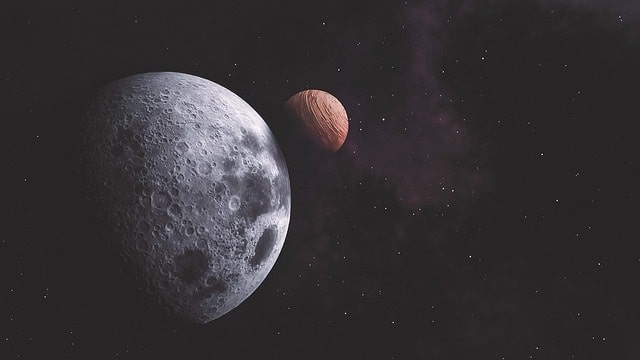
Astronomy is the oldest of the natural sciences.1
In early historical times, astronomy only consisted of the observation and prediction of the motion of objects visible to the naked eye. Early cultures identified celestial objects with gods and spirits, who they then related to natural phenomena such as rain, drought, seasons, and tides. In some locations, structures such as mounds of soil were assembled, which served as artificial horizons in places where the horizon was irregular and fragmented, such as forests and mountains.
The oldest astronomical drawings that have survived to this day are from the Lascaux caves in France, dating back as far as 17,000 years ago.2It has been suggested that some of these drawings represent the constellations of Orion, Taurus, and the Pleiades.
Western astronomy first originated in Mesopotamia, the “land between the rivers” Tigris and Euphrates, where the ancient kingdoms of Sumer, Assyria, and Babylonia were located.3The very first astronomers are believed to have been the Chaldeans, who lived in Mesopotamia around 1000 BC. Led by the prominent scientific figures Naburiannu and Kidinnu, they soon became known for the accuracy with which they could predict eclipses.4
Early Greek astronomers learned from the Chaldeans. Around 500 BC, the Greek philosopher Pythagoras noticed that the so-called evening star and morning star were the same body, the planet Venus.5 The first accurate measurement of the size of the Earth is owed to Eratosthenes of Cyrene. He noticed that the Sun casts a slightly different shadow at the same time of the day when observed from Syene and Alexandria, two cities at a known distance, which led him to correctly estimate the radius of the Earth.[Tretkoff E. June, ca. 240 B.C. Eratosthenes Measures the Earth. Journal of the American Physical Society. 2006;15(6). https://www.aps.org/publications/apsnews/200606/history.cfm. Accessed January 20, 2021.[/efn_note]
Ancient Egyptians were also interested in the night sky. They depended on the Nile River to flood their fields and leave a trace of fertile land which could be used for agriculture. Having discovered the periodicity of these floods, they became the first people to use a calendar with a 365-day year.6 Egypt later became the center of scientific activity across the Hellenistic world. A key figure of this time was Ptolemy, the author of the Almagest. He canonized a geocentric model of the universe, which was accepted as the scientific truth for more than 1,200 years, until Nicolaus Copernicus finally disproved it in 1543.7
Nowadays, astronomy is not a standalone subject, but it is strongly interlinked with astrophysics and cosmology, fields that are concerned with the study of the physical phenomena governing the evolution of stars, galaxies, and the early universe. For centuries, the study of astronomy was moved forward both by divination and utility. Now we study astronomy to understand our place in the universe, where we came from, and where we are going. It’s no wonder astronomy for kids is such a fascinating activity to get them involved in.
The ultimate goal of a scientific education is to have a society of people who are smart enough to make informed choices.
How to Find the Best Place to Stargaze with Kids

If you live in a big city, take some time to travel to a quieter and darker place. If your view of the horizon is obstructed by tall buildings or trees, find an elevated place nearby that is free of obstacles. If you live near the mountains, consider moving as high up as you can. Starlight is absorbed and scattered by the atmosphere, so the higher you move, the clearer the sky will be. For those of you lucky enough to have a terrace or garden, living in the countryside or in a small town, your home is an excellent place to start.
Be sure to check the weather forecast, as clouds can reduce your visibility. Winter is the best season for stargazing as there is less moisture in the air, which can obscure starlight.
Choose a night when there is a new moon, since a quarter or full moon can obscure many of the fainter stars in the sky.
How to Get Your Kids Started in Astronomy
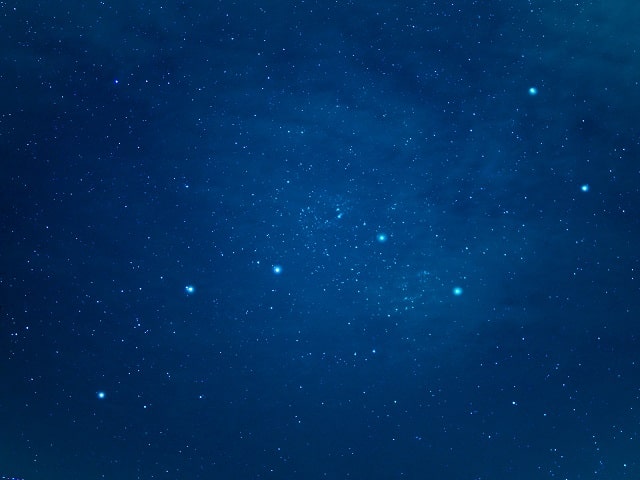
Simply enjoying a clear night sky can be more than satisfying for many, while others might want to gain more familiarity with the stars.
If you manage to find a place that is not too polluted, you will be amazed by the sheer number of stars you can see – around 2,500 to be exact!8 It is easy to get lost without the right tools.
There are many tools at your disposal that make it easier to get into astronomy for kids. For example, there are several apps you can install on your computer or phone that will aid you in the observation of the night sky. Some are free, like SkyView, while others come at a very accessible price of $2.99, like Stellarium. The latter is free on computers, but the phone version might be handier, especially if you want to have it with you while stargazing. Both apps have a GPS function, which will allow you to point your phone in any given direction and discover which stars are located at that point. This will be especially useful when you’re just getting started with astronomy for kids, when you are not yet familiar with the night sky.
Both SkyView and Stellarium will automatically start at the current time of the day. Just fast-forward a few hours to see what the sky will be like that night. You have the option to highlight the constellations, so start with memorizing a few of them. The Big Dipper, Little Dipper, and Cassiopeia are all excellent constellations to familiarize yourself with to start.
Since the Big Dipper is usually the easiest constellation to find, it’s worth coming up with a few tricks that will help you find other constellations starting from that one. As an example, notice how the Big Dipper has two parts – a bowl and a handle. Look at the outer two stars in the bowl of the Big Dipper, which are farthest from the handle. These are often called pointer stars, as they point to the North Star, also known as Polaris, the last in the handle of the Little Dipper.9
After you memorize a few constellations, look for the brightest planets (Mars, Jupiter, and Saturn) and try to remember their positions relative to the constellations that night. Venus and Mercury can only be seen slightly before dawn or shortly after sunset, so those will require a bit more experience and planning to observe. Remember, if you can’t find the object you’re looking for, there’s a search window where you can simply type in the name, and the app will automatically point in the right direction, making astronomy for kids easier than ever before.
Of course, you can bring your phone with you on the day of observation. If you’re curious to know what a particular star in the sky is, you can point your phone in that direction using the GPS function. Just remember to lower the luminosity of your phone and to use the night mode provided in both apps. This will automatically turn the color scheme to red, which causes minimal disturbance to eye adaption at night.
What to Look For (and When)
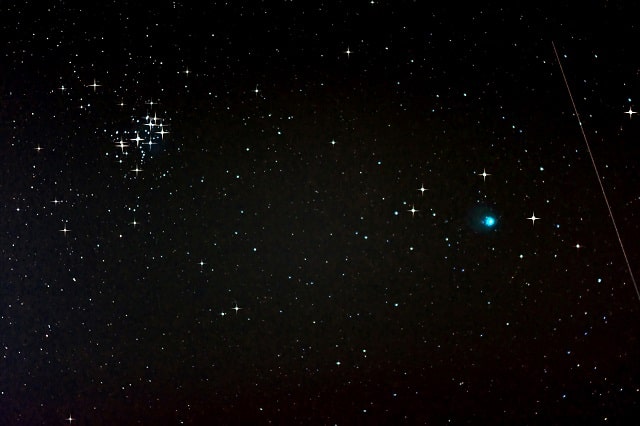
If you’ve just started stargazing, don’t buy any special equipment just yet.
If your chosen location gives you access to a clear night sky, you should be all set to start your first stargazing session. First, look for the constellations you can remember, either from previous experience or from your earlier observations on the SkyView or Stellarium app.
In the Northern Hemisphere, some constellations, like the Big and Little Dipper, Draco, and Cassiopeia, are always visible at night (weather permitting), while others are only visible in certain months, depending on the position of the Earth relative to the Sun.
For instance, during winter you will be able to observe the constellations of Orion, Taurus, Gemini, and Auriga, the same constellations which were first depicted in the Lascaux caves in France more than 17,000 years ago!10 What a beautiful way to connect to our ancestors.
You’ll also notice the Winter Triangle, formed by Sirius, the brightest star in the night sky, located in the constellation of Canis Major, Betelgeuse, in the constellation of Orion, and Procyon, in the constellation of Canis Minor.11 During summer, you will recognize the constellations of Lyra, Cygnus, and Aquila. Their brightest stars, Vega, Deneb, and Altair form the Summer Triangle.12
Once you have gained enough familiarity with the constellations and the planets, you should decide whether to buy a telescope. Check out our guide to learn how much a good telescope costs and how to get the best value for your money. If you buy a telescope, you can move on to observing star clusters, nebulae, and galaxies, collectively referred to as “Deep Sky Objects” (DSOs).13
Latitude and seasons influence the visibility of DSOs significantly. Most DSOs are at their peak of visibility for only about a month.14 Part of the joy in astronomy for kids is discovering the object itself, taking the time to hunt and locate a galaxy or nebula, especially if it’s at the limit of your equipment’s abilities.
During spring, some of the most beautiful DSOs you can observe are the Whirlpool Galaxy (M51), the Leo Triplet (M66 group), and the Virgo Cluster (with 16 Messier objects). During summer, you can observe the Dumbbell nebula (M27), the Trifid Nebula (M20), the Smoke Ring Nebula (M57), and the Cluster in Hercules (M13).15
Towards fall and winter, you will see the Andromeda Galaxy (M31, our neighbouring galaxy), the Double Cluster in Perseus, the Pleiades (M45), and the Nebula in Orion (M42).16
What Makes Astronomy So Cool?
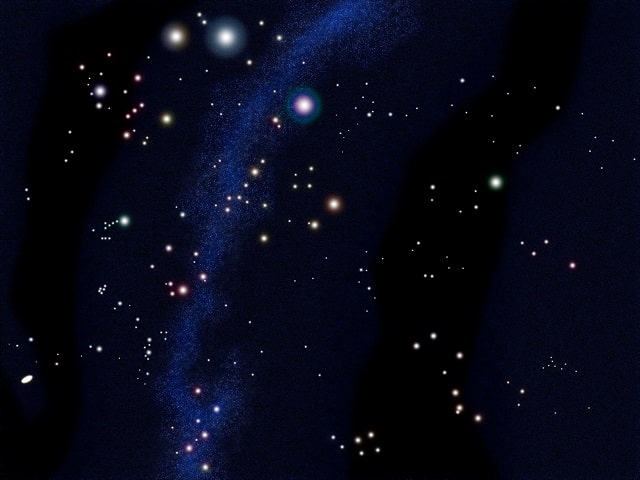
The relation between the time of the year and the constellations visible at night was the first powerful feature our ancestors noticed when looking at the stars. It would help them decide when to plant crops, but it also served as a means of forecasting recurring events.
As your knowledge expands, you will remember, for instance, that Sirius culminates (i.e., passes through the southern meridian) at exactly midnight on the 1st of January, while Spica (in the constellation of Virgo) culminates at midnight on the 1st of May.1718
All of this is coded in the so-called right ascension of the stars. By knowing this number, which you can easily find in any interactive sky map, you’ll be able to tell at what time of the year a particular star can be observed in a given direction. Indeed, all this heavy lifting is done on your phone or computer by the apps mentioned earlier. Our knowledge is so accurate that we can map out what the sky will look like in the next million years or so.
Reversing our argument, if we know the time and date accurately (we have a good watch), we can look at the night sky and tell in what direction we are pointing. This is how sailors crossed the Atlantic more than 600 years ago.19 The main problem was not the measurement of the position of the stars, which could be carried out accurately with a sextant, but rather the measurement of time, as clocks weren’t that precise at that time.
Celestial navigation was also used by pilots back when there were no GPS receivers. Aviators will tell you how they had the luxury of choosing from more than 63 navigation aids. They relied on the Sun and the Moon along with several planets, including Jupiter, Mars, Venus, and Saturn, as well as 57 stars with excellent visibility in the night sky to aid navigators. Imagine crossing the Atlantic Ocean in a Cessna armed with nothing more than a sextant, heading for the Azores, that small cluster of islands situated about 800 miles off the coast of Portugal. Pilots had to be very confident to venture out looking for a few specks of terra firma in the middle of an ocean spanning 36 million square miles.20
What Do Kids Need for Stargazing?
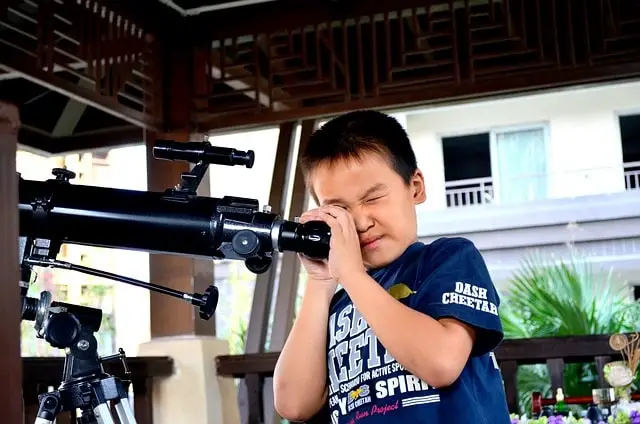
When you’re first getting started with astronomy for kids, all you really need is to go out there and stargaze with your eyes only. Later on, you might decide to buy a telescope. If you don’t want to spend too much money, you can start with a pair of 7×50 binoculars, the most popular size for stargazing. If you can afford to spend more, then look for telescopes around $200-$300.
According to National Geographic, “The main features to look for in a telescope are a high-quality lens, a rock-solid mount, and a set of two or three eyepieces that you can use to change magnification.”21The two main types of telescopes you will come across are (Galilean) lens-based refractors and (Newtonian) reflectors, which focus starlight using mirrors.22
For an in-depth look at the equipment you might need for astronomy, check out our guide to Astronomy Tools for Observing the Night Sky
How to Get Kids Excited About Astronomy
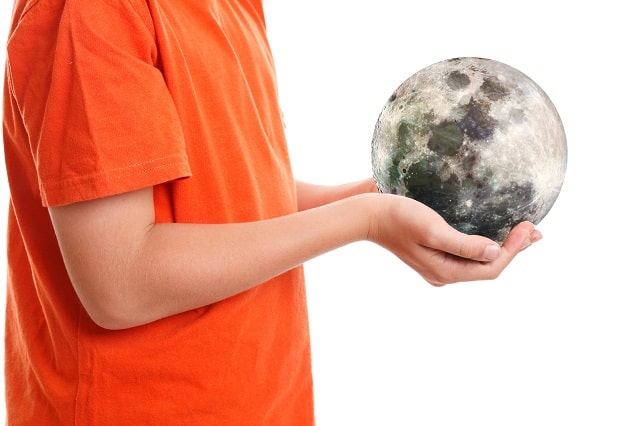
When it comes to astronomy for kids, the most obvious place to start is the Moon. According to National Geographic, “The best time to explore the Moon’s surface with a telescope or binoculars is when its disk is half lit,” which is known as the quarter moon, “or when it’s a cresent.” National Geographic recommends paying particular attention to the boundary line between the bright and the dark side of the disk, as this region provides the best views of long shadows cast by mountain ranges and crater rims.23
Even with the naked eye, you will clearly see two distinct regions on the Moon: light areas, called terrae (or highlands), and darker areas, called maria.24 The maria were once thought to be seas and oceans and were given beautiful names such as Oceanus Procellarum, Mare Tranquillitatis, and Sinus Iridum (the Ocean of Storms, the Sea of Tranquillity, and the Bay of Rainbows).25
“Encourage children to imagine what it was like for the Apollo 13 astronauts as they looked out their spacecraft at the moon below, as they orbited it more than 50 years ago,” National Geographic suggests. “One idea for an astronomy-themed project: have kids take photos of the Moon as it cycles through its monthly phases. To make the photos more dramatic, frame them with foreground objects like your house or a tree, or maybe yourself—a lunar selfie.”26 At the end of the month, you can create a collage with all these pictures.
Second, you can look for the International Space Station (ISS). From most locations on Earth, when the visibility is good, the ISS will appear to the naked eye as a bright star as it rises to the west and quickly sets to the east, all in a matter of minutes. To find out when the ISS passes overhead from your location, you can sign up to NASA’s free tool, Spot the Station, and receive alerts when the ISS will be visible from your location – no matter where in the world you are. Typically, alerts are sent out a few times each month when the station’s orbit is near your location.
You can then move on to planets, which will require at least binoculars, although a telescope is better. Start with Jupiter and observe its four largest moons, first discovered by Italian astronomer Galileo over 400 years ago.27 As an idea for another exercise, ask them to draw the position of each moon next to Jupiter. The following night or two, check them out again and see how the moons have shifted positions.
Last but not least, observe meteor showers. “Nothing gets a kid more excited about stargazing than seeing flaming chunks of interplanetary debris streak through the atmosphere,” says Michael Howard in an article published by Fatherly. “There are plenty of meteor shower maps you can use to schedule stargazing nights for maximum impact. Whether you choose to disclose all this to your kid, or simply drag them outside one night while screaming about an alien invasion, is entirely up to you,” Howard explains.28
A Few Important Stargazing Dos and Don’ts
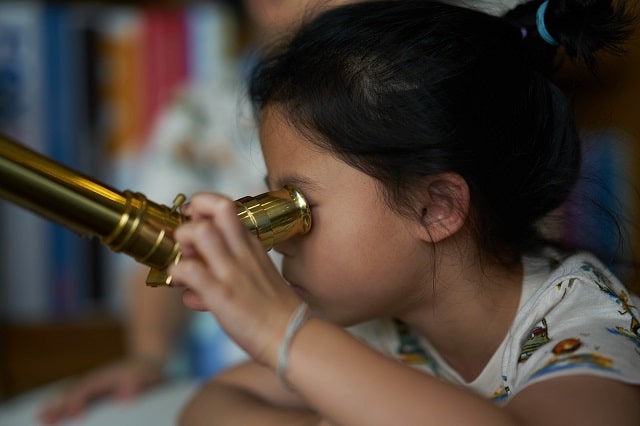
- Read books and explore the internet, there is plenty of information out there on astronomy for kids. For instance, you can use an atlas together with the SkyView or Stellarium app, such as Pocket Sky Atlas.
- When stargazing, try not to use your phone or turn on lights too often. It takes 20 minutes or so for your eyes to establish night vision. Red lights on a viewing night are much appreciated, as they don’t interfere with night vision nearly as much.29
- Try to use your telescope with both eyes open, as it will help lessen eye strain over the course of an evening.
- “Keep your feet and body warm and dry. When standing still on a cold night your body temperature will drop very quickly and soon spoil a great evening,” Seven Sisters Astronomical Society recommends.30
- Try to avoid “department store” telescopes, which are usually of such inferior quality they will ruin a potential good start of an interesting hobby. “Typically, if the packaging seems to focus on magnification (‘up to 1000x magnification!’) you should just walk away,” John Nangreaves and David Chapman recommend in an article published at Astronomy Nova Scotia.31 If you’re thinking, “I won’t buy anything expensive in case I/they don’t like astronomy after all,” which is perfectly reasonable, then stop and don’t buy a telescope at all. Instead, start with a good pair of binoculars. Should you decide to go for a telescope, a good place to start is a Sky-Watcher 6” Dobsonian, which costs around $300.
- Visit clubs and associations nearby. “Amateur astronomers are always willing to help newcomers, just as they were helped when they started, and have strong convictions about continuing that tradition,” Nangreaves and Chapman point out. Most independent clubs have regular open monthly meetings and encourage the public to attend.32
Astronomy for kids is a fascinating hobby, not just for kids but also adults, and is an excellent activity for spending some quality time with your children. Following these tips for a successful stargazing start will help you find intriguing objects in the night sky. Getting your kids into stargazing might just spark a lifelong interest in astronomy and other STEM areas.
Flavio Salvati studies Physics at the University of Cambridge. He has written a book on astronomy, titled “Fundamentals of Astronomy. A guide for Olympiads.” During the summer holidays, Flavio has had the opportunity of working in the Quantum Matter group, in Cambridge, at the MagLab, in Florida, and the Max Planck Institute, in Germany. When he is not busy studying physics or astronomy, Flavio can be found playing Beethoven’s sonatas, fencing, or piloting a glider Schleicher K 21 above the fields of Cambridgeshire.
Additionally, if you’re looking for additional resources on stargazing, we have a number of articles that you might find interesting.
First off, we’ve created guides on a variety of astronomy related topics, such as our guide to determining how much a telescope should cost, our guide to how to use a telescope, our beginner’s guide to astronomy, and our guide on how to buy your first telescope. We’ve also created a series of helpful guides for kids, such as our list of astronomy facts (which any kids or beginners will no doubt find interesting), and our breakdown of astronomy for kids (which you’re reading right now).
We’ve also created a series of buying guides, including our guide to find the best astronomy tools for you, our guide to evaluating the best telescopes for beginners, and our guide to the best astronomy binoculars.
In addition to those guides, we’ve also created a series of in-depth reviews of a variety of telescopes and astronomy binoculars. You can check them out before you buy to find out the best accessories, pros and cons for different models, and even to see what they look like unboxed. If you’re considering buying a telescope we have a series of reviews that also serve as how to guides. You can get our series of guides to individual telescopes as well, including our review of the following telescopes and binoculars: our Celestron Firstscope review, Celestron Travel Scope 80 Telescope Review, SkyGenius 10×50 Binoculars review, Celestron Travel Scope 80 Telescope review, Opticron Adventurer II 10×50 Binocular review, Orion Astronomy 15×70 Binoculars review, Orion XT6 Dobsonian Telescope review, Orion Scenix 7×50 Binocular review, Celestron ExploraScope 114AZ Telescope review, Zhumell Z100 Telescope review, and our Sky-Watcher Heritage 130 Telescope reviews, to really be able to dive into the different telescope and astronomy binocular models.
Article Sources
Moon and Back uses only high-quality sources, including peer-reviewed studies, to support the facts within our articles. Read our editorial process to learn more about how we fact-check and keep our content accurate, reliable, and trustworthy.
- Betz E. Why astronomy is considered the oldest science. Astronomy.com. https://astronomy.com/news/2020/10/why-astronomy-is-considered-the-oldest-science. Published October 6, 2020. Accessed January 20, 2021.
- Andrei M. Ancient cave paintings may be sign of prehistoric astronomy. Zmescience.com. https://www.zmescience.com/science/news-science/ancient-cave-paintings-astronomy-28112018/. Published April 25, 2019. Accessed January 20, 2021.
- Shuttleworth M. Mesopotamian Astronomy. Explorable.com. https://explorable.com/mesopotamian-astronomy. Published October 10, 2010. Accessed January 20, 2021.
- Turner HH. The Oldest Astronomers Known. Publications of the Astronomical Society of the Pacific. 1929;41(243):291. doi:10.1086/123957
- Cessna A. Evening Star. Universetoday.com. https://www.universetoday.com/42452/evening-star/. Published October 13, 2009. Accessed January 20, 2021.
- Ancient Egyptian Calendar. Historyembalmed.org. http://www.historyembalmed.org/ancient-egyptians/ancient-egyptian-calendar.htm. Accessed January 21, 2021.
- Jones AR. Ptolemaic system. Britannica.com. https://www.britannica.com/science/Ptolemaic-system. Published May 19, 2020. Accessed January 21, 2021.
- How many stars can you see? Earthsky.org. https://earthsky.org/astronomy-essentials/how-many-stars-could-you-see-on-a-clear-moonless-night. Published February 26, 2018. Accessed January 21, 2021.
- McClure B. Come to know the Big and Little Dippers. Earthsky.org. https://earthsky.org/favorite-star-patterns/big-and-little-dippers-highlight-northern-sky. Published March 25, 2020. Accessed January 21, 2021.
- Andrei M. Ancient cave paintings may be sign of prehistoric astronomy. Zmescience.com. https://www.zmescience.com/science/news-science/ancient-cave-paintings-astronomy-28112018/. Published April 25, 2019. Accessed January 20, 2021.
- The Winter Triangle Asterism. Thenineplanets.org. https://nineplanets.org/the-winter-triangle/. Published July 14, 2020. Accessed January 21, 2021.
- Howell E. Summer Triangle: Asterism of 3 Stars From 3 Constellations. Space.com. https://www.space.com/28061-summer-triangle.html. Published August 14, 2017. Accessed January 21, 2021.
- Bakich ME. The deep sky. Astronomy.com. https://astronomy.com/observing/tour-the-deep-sky/2010/03/the-deep-sky. Published March 15, 2010. Accessed January 21, 2021.
- War A. 12 Best Deep Space Objects for Backyard Astronomers – Part One. Lovethenightsky.com. https://lovethenightsky.com/best-deep-space-objects-pt-1/. Accessed January 21, 2021.
- War A. 12 Best Deep Space Objects for Backyard Astronomers – Part One. Lovethenightsky.com. https://lovethenightsky.com/best-deep-space-objects-pt-1/. Accessed January 21, 2021.
- War A. 12 Best Deep Space Objects for Backyard Astronomers – Part Two. Lovethenightsky.com. https://lovethenightsky.com/best-deep-space-objects-pt-2/. Accessed January 21, 2021.
- McClure B. Star Sirius rings in New Year! Earthsky.org. https://earthsky.org/astronomy-essentials/star-sirius-torchbearer-of-the-new-year. Published December 31, 2020. Accessed January 21, 2021.
- Spica. Constellation-guide.com. https://www.constellation-guide.com/spica/. Published August 25, 2014. Accessed January 21, 2021.
- Tyson P. Secrets of Ancient Navigators. Pbs.org. https://www.pbs.org/wgbh/nova/article/secrets-of-ancient-navigators/. Published October 6, 1998. Accessed January 21, 2021.
- Casner SM. Celestial Navigation. Aopa.org. https://www.aopa.org/news-and-media/all-news/2003/april/pilot/celestial-navigation. Published April 5, 2003. Accessed January 21, 2021.
- Fazekas A. Need a new idea to keep kids entertained? Try stargazing. Nationalgeographic.com. https://www.nationalgeographic.com/family/2020/04/idea-to-keep-kids-entertained-try-stargazing/#close. Published April 14, 2020. Accessed January 21, 2021.
- Tyson P. Two Types of Telescopes. Pbs.org. https://www.pbs.org/wgbh/nova/galileo/telescope.html. Accessed January 21, 2021.
- Fazekas A. Need a new idea to keep kids entertained? Try stargazing. Nationalgeographic.com. https://www.nationalgeographic.com/family/2020/04/idea-to-keep-kids-entertained-try-stargazing/#close. Published April 14, 2020. Accessed January 21, 2021.
- Christiansen EH, Spilker B. Chapter 4. The Moon. Explanet.info. https://explanet.info/Chapter04.htm. Accessed January 21, 2021.
- Lunar Features of the Month Archive. Starfieldobservatory.com. http://www.starfieldobservatory.com/LFOTM.htm. Updated January 1, 2021. Accessed January 21, 2021.
- Fazekas A. Need a new idea to keep kids entertained? Try stargazing. Nationalgeographic.com. https://www.nationalgeographic.com/family/2020/04/idea-to-keep-kids-entertained-try-stargazing/#close. Published April 14, 2020. Accessed January 21, 2021.
- Uri J. 410 Years Ago: Galileo Discovers Jupiter’s Moons. Nasa.gov. https://www.nasa.gov/feature/410-years-ago-galileo-discovers-jupiter-s-moons. Published January 9, 2020. Accessed January 21, 2021.
- Howard M. A Guy Building The Next Hubble Telescope On Stargazing With Your Kid. Fatherly.com. Published August 6, 2015. Accessed January 21, 2021.
- Stargazing Dos and Don’ts. Ssasonline.wordpress.com. https://ssasonline.wordpress.com/about-ssas/stargazing-dos-and-donts/. Accessed January 21, 2021.
- Stargazing Dos and Don’ts. Ssasonline.wordpress.com. https://ssasonline.wordpress.com/about-ssas/stargazing-dos-and-donts/. Accessed January 21, 2021.
- Nangreaves J, Chapman D. Buying a New Telescope—Dos and DON’Ts. AstronomyNovaScotia.ca. https://www.astronomynovascotia.ca/index.php/articles/5-buying-a-new-telescope-dos-and-don-ts. Accessed January 21, 2021.
- Nangreaves J, Chapman D. Buying a New Telescope—Dos and DON’Ts. AstronomyNovaScotia.ca. https://www.astronomynovascotia.ca/index.php/articles/5-buying-a-new-telescope-dos-and-don-ts. Accessed January 21, 2021.
